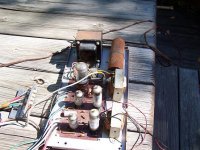Bruce,
I'm guessing that the tube set is a 5Y3 rectifier, 2X 12AX7s, and 2X 6BQ5s.
The phenolic PCBs are junk. Salvage the "iron" and the tubes. Buy a large, deep, plain Aluminum baking pan as the new chassis.
I suggest you follow (more or less) the DECWARE SE84 model. Triode wire the O/P tubes and use 2 triodes (possibly a twin) for voltage amplification. GE used 2 small signal stages in each channel to deal with tone control losses. If you are lucky, a no NFB circuit will work. Frankly, I have my doubts about the quality of the O/P trafos. Mediocre O/P "iron" needs help from loop NFB, particularly in obtaining satisfactory bass performance. 2X 6GK5s will do nicely in a circuit with loop NFB. A single 12AV7 family type will do in a no NFB design.
The least costly way to obtain control over both listening level and channel to channel balance is to employ a pair of single (mono) log taper potentiometers.
I'm guessing that the tube set is a 5Y3 rectifier, 2X 12AX7s, and 2X 6BQ5s.
The phenolic PCBs are junk. Salvage the "iron" and the tubes. Buy a large, deep, plain Aluminum baking pan as the new chassis.
I suggest you follow (more or less) the DECWARE SE84 model. Triode wire the O/P tubes and use 2 triodes (possibly a twin) for voltage amplification. GE used 2 small signal stages in each channel to deal with tone control losses. If you are lucky, a no NFB circuit will work. Frankly, I have my doubts about the quality of the O/P trafos. Mediocre O/P "iron" needs help from loop NFB, particularly in obtaining satisfactory bass performance. 2X 6GK5s will do nicely in a circuit with loop NFB. A single 12AV7 family type will do in a no NFB design.
The least costly way to obtain control over both listening level and channel to channel balance is to employ a pair of single (mono) log taper potentiometers.
- Status
- Not open for further replies.
